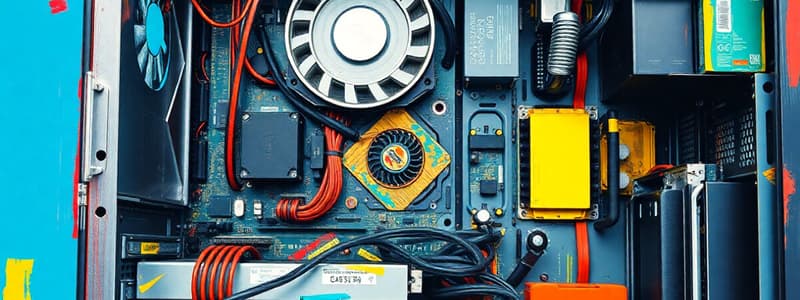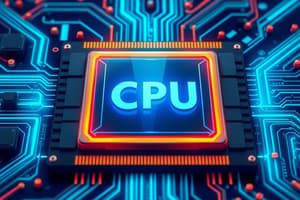Podcast
Questions and Answers
Before detaching any internal components from a PC, what crucial step should be taken to aid in reassembly?
Before detaching any internal components from a PC, what crucial step should be taken to aid in reassembly?
- Lubricate all connectors with a silicone-based spray.
- Take pictures of the connections and component placements. (correct)
- Label each component with a permanent marker.
- Record a detailed video of the disassembly process.
When disassembling a PC, what is the recommended method for removing dust and debris from the interior?
When disassembling a PC, what is the recommended method for removing dust and debris from the interior?
- Use a vacuum cleaner with a brush attachment.
- Rinse the components with isopropyl alcohol.
- Wipe down all surfaces with a damp cloth.
- Blow out dust and debris with compressed air. (correct)
Why is it important to avoid over-tightening screws when reassembling a PC?
Why is it important to avoid over-tightening screws when reassembling a PC?
- It helps distribute thermal paste evenly.
- It ensures proper airflow within the system.
- It can damage the components or strip the screw threads. (correct)
- It prevents the screws from being easily removed in the future.
Which of the following components directly connects to the PSU (Power Supply Unit)?
Which of the following components directly connects to the PSU (Power Supply Unit)?
What should you, according to the content, do with the screws you remove?
What should you, according to the content, do with the screws you remove?
Why is it important to wear an ESD wrist strap when disassembling a computer?
Why is it important to wear an ESD wrist strap when disassembling a computer?
When removing RAM sticks, what is the correct method to release them from their slots?
When removing RAM sticks, what is the correct method to release them from their slots?
Which of the following should be disconnected from the hard drive before removing it from the computer case?
Which of the following should be disconnected from the hard drive before removing it from the computer case?
Where is the video card typically located inside a computer case?
Where is the video card typically located inside a computer case?
Before disassembling any parts of the PC, why should you press and hold the power button for a few seconds?
Before disassembling any parts of the PC, why should you press and hold the power button for a few seconds?
What type of connector do SATA data cables typically have?
What type of connector do SATA data cables typically have?
When removing the CPU, why is it important to consult the motherboard's manual?
When removing the CPU, why is it important to consult the motherboard's manual?
Where is the CMOS battery typically located?
Where is the CMOS battery typically located?
Flashcards
Power Supply Unit (PSU)
Power Supply Unit (PSU)
The component that provides electrical power to the computer's parts.
Disassembly Tips
Disassembly Tips
Important guidelines to follow when disassembling a computer.
Reassembly Process
Reassembly Process
The steps to put a computer back together after disassembly.
Identifying Components
Identifying Components
Signup and view all the flashcards
Cleaning Interior
Cleaning Interior
Signup and view all the flashcards
ESD Wrist Strap
ESD Wrist Strap
Signup and view all the flashcards
Turn Off Your Computer
Turn Off Your Computer
Signup and view all the flashcards
Hard Drive
Hard Drive
Signup and view all the flashcards
RAM
RAM
Signup and view all the flashcards
Video Card
Video Card
Signup and view all the flashcards
SATA Data Cable
SATA Data Cable
Signup and view all the flashcards
CPU
CPU
Signup and view all the flashcards
Motherboard
Motherboard
Signup and view all the flashcards
Study Notes
Disassembling a PC: Safety Precautions
- Turn off the computer, unplug the power cord, and press and hold the power button for a few seconds to discharge any residual power.
- Use an ESD wrist strap to ground yourself, attaching the clip to a metal surface on the computer case and securing the strap to your wrist. This avoids static electricity damage.
Disassembling a PC: Opening the Case
- Locate release catches or buttons on either side of the computer case.
- Press the buttons or lift the latches to unclip the side panels.
- Carefully remove the side panels.
Disassembling a PC: Removing Internal Components
- Hard Drive:
- Locate the hard drive (3.5" or 2.5").
- Disconnect the SATA Data Cable (L-shaped connector).
- Disconnect the SATA Power Cable.
- Optical Drive:
- Locate the CD/DVD drive.
- Disconnect the SATA Data Cable (if connected).
- Unscrew and remove the drive.
- RAM:
- Locate the RAM sticks near the processor.
- Gently press down on the spring-loaded clips at each end.
- Pull the stick up and out of its slot. (Remove all RAM sticks).
- Video Card:
- Locate the video card (typically long, with a fan, and connected with metal connectors).
- Remove the screw securing it in place.
- Press down on the latch, or gently pull it out, to release it.
- CPU (Critical):
- Be extremely cautious when handling the CPU. It is under the heatsink/fan.
- Consult the motherboard manual for detailed instructions before removing it.
Disassembling a PC: Additional Components
- Motherboard: Carefully remove any small round batteries found on the motherboard.
- SATA Cables: Disconnect both ends of SATA data and power cables connecting drives to the motherboard and power supply unit (PSU).
- PSU (Power Supply Unit):
- Unplug all wires connected to the PSU.
- Unscrew and carefully remove the PSU from the computer case.
Disassembling a PC: Important Tips
- Handle parts gently: Computer components are delicate.
- Take pictures: Document the connections before disconnecting components to aid reassembly.
- Return everything to its original locations: Put screws in secure containers, along with other small items.
- Cleanup: Use compressed air to remove dust from inside the computer case.
Disassembling a PC: Reassembly
- Carefully reverse the disassembly steps.
- Match wires by color/shape to the right connectors.
- Use the pictures as guidance to ensure accurate placement.
- Do not over-tighten screws.
- Consult the motherboard guide for specific instructions.
Studying That Suits You
Use AI to generate personalized quizzes and flashcards to suit your learning preferences.



